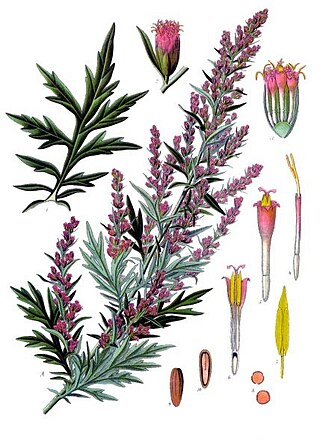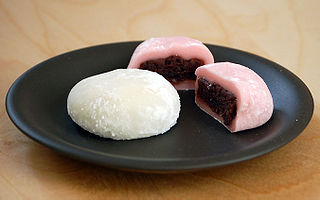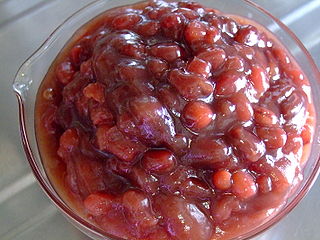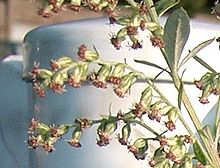
Dango is a Japanese dumpling made with regular rice flour and glutinous rice flour. They are usually made in round shapes, and three to five pieces are served on a skewer, which is called kushi-dango (串団子). The pieces are eaten with sugar, syrup, red bean paste, and other sweeteners. Generally, dango falls under the category of wagashi, and is often served with green tea. It is eaten year-round, but the different varieties are traditionally eaten in given seasons. Dango is sometimes compared with mochi, but is different in that mochi is generally made only with glutinous rice.

Mochi is a Japanese rice cake made of mochigome (もち米), a short-grain japonica glutinous rice, and sometimes other ingredients such as water, sugar, and cornstarch. The steamed rice is pounded into paste and molded into the desired shape. In Japan, it is traditionally made in a ceremony called mochitsuki. While eaten year-round, mochi is a traditional food for the Japanese New Year, and is commonly sold and eaten during that time.

Moxibustion is a traditional Chinese medicine therapy which consists of burning dried mugwort on particular points on the body. It plays an important role in the traditional medical systems of China, Japan, Korea, Vietnam, and Mongolia. Suppliers usually age the mugwort and grind it up to a fluff; practitioners burn the fluff or process it further into a cigar-shaped stick. They can use it indirectly, with acupuncture needles, or burn it on the patient's skin.

Wagashi is a traditional Japanese confection made of mochi, anko, and fruit. Wagashi is typically made from plant-based ingredients with an emphasis on seasonality, and generally making use of cooking methods that pre-date Western influence in Japan. It is often served with green tea.

Kusa mochi, also known as yomogi mochi (蓬餅), is a Japanese confection. It is made from mochi and leaves of yomogi. The leaves are kneaded into the mochi, giving it a vivid green color. The greenness depends on the amount of Japanese mugwort blended in the mochi.

A rice cake may be any kind of food item made from rice that has been shaped, condensed, or otherwise combined into a single object. A wide variety of rice cakes exist in many different cultures in which rice is eaten. Common variations include cakes made with rice flour, those made from ground rice, and those made from whole grains of rice compressed together or combined with some other binding substance.

Mugwort is a common name for several species of aromatic flowering plants in the genus Artemisia. In Europe, mugwort most often refers to the species Artemisia vulgaris, or common mugwort. In East Asia the species Artemisia argyi is often called "Chinese mugwort" in the context of traditional Chinese medicine, Ngai Chou in Cantonese or àicǎo (艾草) for the whole plant in Mandarin, and àiyè (艾叶) for the leaf, which is used specifically in the practice of moxibustion. Artemisia princeps is a mugwort known in Korea as ssuk (쑥) and in Japan as yomogi (ヨモギ). While other species are sometimes referred to by more specific common names, they may be called simply "mugwort" in many contexts.

Qīngtuán, also written as Tsingtuan, is a green-colored dumpling originating from Jiangnan and common throughout China. It is made of glutinous rice mixed with Chinese mugwort or barley grass. It is usually filled with sweet red or black bean paste. The exact technique for making qingtuan is quite complicated and the grass involved is only edible in the early spring, so it is typically only available around the time of the Qingming Festival (April 4 or 5), with which the rice cake has become associated. Nowadays, qingtuan sold in most convenience stores in China are made of glutinous rice mixed with matcha. Modern versions use a wider variety of fillings, such as rousong or salted egg yolk.
Korean regional cuisines are characterized by local specialties and distinctive styles within Korean cuisine. The divisions reflected historical boundaries of the provinces where these food and culinary traditions were preserved until modern times.

Artemisia argyi, commonly known as silvery wormwood or Chinese mugwort, is a herbaceous perennial plant with a creeping rhizome. It is native to China, Korea, Mongolia, Japan, and the Russian Far East. It is known in Chinese as àicǎo or ài yè or ài hao, in Japanese as Chōsen yomogi and in Korean as Hwanghae ssuk. It is used in herbal medicine for conditions of the liver, spleen and kidney.

Zanthoxylum piperitum, also known as Japanese pepper or Japanese prickly-ash, is a deciduous aromatic spiny shrub or small tree of the citrus and rue family Rutaceae, native to Japan and Korea.

Daifukumochi (大福餅), or daifuku (大福), is a wagashi, a type of Japanese confection, consisting of a small round mochi stuffed with a sweet filling, most commonly anko, a sweetened red bean paste made from azuki beans. Daifuku is a popular wagashi in Japan and is often served with green tea.

Red bean paste or red bean jam, also called adzuki bean paste or anko, is a paste made of red beans, used in East Asian cuisine. The paste is prepared by boiling the beans, then mashing or grinding them. At this stage, the paste can be sweetened or left as it is. The color of the paste is usually dark red, which comes from the husk of the beans. In Korean cuisine, the adzuki beans can also be husked prior to cooking, resulting in a white paste. It is also possible to remove the husk by sieving after cooking, but before sweetening, resulting in a red paste that is smoother and more homogeneous.

Ssukcha (Korean: 쑥차), also called mugwort tea or wormwood tea, is a traditional Korean tea made from Korean mugwort. It is commonly consumed in both North and South Korea.






















